|
||
|
|
||
| CORNUS kousa
'National' This magnificent cultivar is of dense, rounded habit and the large bracts are very freely produced. They open white, then deepen to pink as they mature. This gives an interesting bicolour effect across the whole plant and maximises the time of interest. |
||
|
|
||
| CORNUS kousa
'Ohkan' I find myself increasingly shying away from the continuing stream of variegated Cornus kousa cultivars becoming available. Yet this Japanese selection is definitely worth having. I can liken it to our own selection ‘Greta’s Gold’, but, much as it pains me to admit it, this one is better! The green and yellow variegation is much cleaner and brighter, and seems more stable too. The typical white bracts in June are followed by rich orange, red and purple autumn colour. Not a vigorous plant though so, as with most variegated plants, it is best when grown with some protection. |
||
|
|
||
 |
CORNUS kousa
'Peve Limbo' Introduced in Holland in 2001, this variegated clone has larger leaves and therefore greater vigour than most other similar selections. The foliage is irregularly margined creamy-white on dark greyish-green, with a yellow flush through the new growth. As with most variegated plants, it is best when grown with some protection. |
|
|
|
||
| CORNUS kousa
'Pollywood' Named after Polly Hill of Massachusetts who selected it, the bracts are essentially white, but creamy towards the middle and subtly tipped with pink. Incredibly prolific, the bracts are produced slightly later and are very long lasting. With time it develops a wonderfully architectural braod and layered habit. Autumn foliage colour can be fabulous, and fruit are also freely produced. One of our favourites, so planted very prominently here. See it in our Winter Garden. |
||
|
|
||
| CORNUS kousa
'PVG' I imagine the cultivar name is the initials of the originator, probably first applied as a "working" name to identify it on the nursery, which then "stuck" as the plant was distributed. To my eyes this is a great plant and a worthwhile selection. I like the tidy, rather upright habit and the bracts are certainly as large and prolific as you could wish for. However, for me its "stand out" feature are the fruit, with it reliably producing probably the biggest and best fruit of any of our C. kousa selections. |
||
|
|
||
 |
CORNUS kousa
'Radiant Rose' This stunning American cultivar continues to impress me with its vigour and beautiful large pink bracts. The fruit were quite incredible too, being plentiful and large. I noted with interest that there is a tremendous difference between the fruit of various cultivars. Although ostensibly the same at first glance, these are very smooth, whilst others are quite bumpy. See it in our Winter Garden. |
|
|
|
||
| CORNUS kousa
'Rasen' Broad creamy white bracts are freely produced, overlapping and reflexing with maturity. Maturing as it does with a broad and layered habit, it is similar to 'Claudia', 'Kreuzdame' and 'Wisley Queen'. All of which also benefit from particularly reliable autumn leaf colours and prolific fruiting. |
||
|
|
||
 |
CORNUS kousa
'Rosemoor Pink' This material came from a very beautiful plant in Lady Ann’s garden at Rosemoor, which had clearly been there for many years. It is good to know that an identical replacement has been planted to replace it when the time comes. Lovely pink bracts, with the pigmentation evident through the purple flushed summer foliage. As is typical of most of the pink bracted selections, the habit is informal and shrubby, rarely producing a dominant leader and thus rarely developing a tree-like shape. |
|
|
|
||
 |
CORNUS kousa
'Satomi' We imported this beautiful form from Japan. The dark pink flower bracts surround a central creamy eye. The bronzey foliage reflects the pink bracts, and develops lovely autumn colours. It is thought that temperature can influence the exact colour of the bract, so there is scope for variation in the intensity of pink. In my experience, it is richer in a more open site than it is in shade. As is typical of most of the pink bracted selections, the habit is informal and shrubby, rarely producing a dominant leader and thus rarely developing a tree-like shape. |
|
|
|
||
|
CORNUS kousa
'Satomi Campact' |
||
|
|
||
|
CORNUS kousa
'Schmetterling' |
||
|
|
||
| CORNUS kousa
'Slui Slim' This recent addition to our collection is reputedly extremely upright and columnar. It is still a young plant, but early indications are certainly that this is the case. At the moment it is growing extremely slowly, so it may be a while before we have this one available. Feel free to drop me through an email to enquire. I find this sort of shape extremely useful for bringing height to a small garden without taking up too much space, or being overly dominant at eye level. I'm looking forward to seeing how it develops. |
||
|
|
||
| CORNUS kousa
'Snowbird' A sturdy and compact form to little more than 3m, making it ideal for the smaller garden. The bracts may also be proportionally smaller, but somehow that just adds to its elegance. |
||
|
|
||
| CORNUS kousa
var. chinensis 'Snowflake' The name reflects the distribution of the flowers and the graceful habit of the plant when in flower. Wrong season though! This one was selected for larger bracts which each have a distinctive wavy edge. This is an absolute favourite of mine, in part due to the way it consistently forms such a nicely shaped plant. See it in our Woodland Walk. |
||
|
|
||
| CORNUS kousa
'Snow Flurry' I can't find much information about this European selection, either in literature or on the internet. Certainly it flowers profusely for us, but I've not really grown it for long enough yet to truly understand its unique characteristics. Early signs are that it's a good one though - so if you fancy snow flurries on your lawn in June, then this is the plant for you! |
||
|
|
||
| CORNUS kousa
'Southern Cross' Creamy white bracts mature through pink, starting with just a delicate pink tip. This extends their "flowering" time very satisfactorily. A delightful New Zealand selection of more stocky habit. |
||
|
|
||
| CORNUS
kousa var. chinensis 'Spinners' Selected by Peter Chappell at Spinners Garden for its profuse flowering. It has a reputation for peak bract production being biennial, though that may be a result of environmental influence. |
||
|
|
||
| CORNUS kousa
'Square Dance' The distinctive large, creamy white bracts overlap to give the appearance of a "square" flower which is always commented upon. Upright growth habit and good autumn colour as well as large fruit. |
||